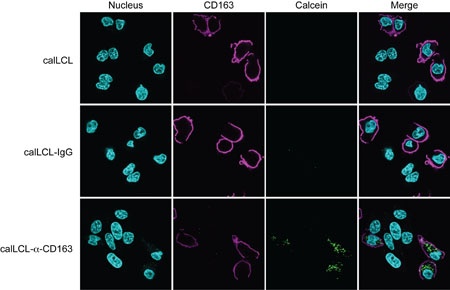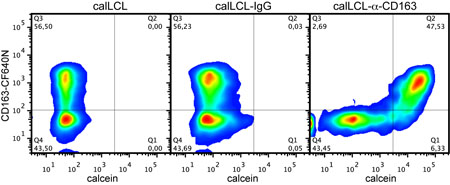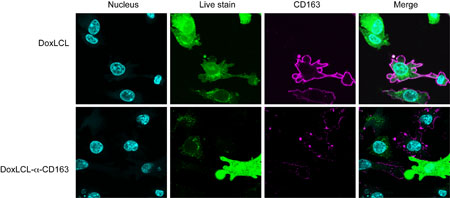Ensuring that the drug reaches its target site remains a key challenge for drug formulators. Anders Etzerodt describes an advanced stealth liposome approach to drug delivery in which confocal laser scanning fluorescence microscopy was used to evaluate the selective targeting of macrophages.
Increasing evidence underlines the importance of macrophages in many diseases, from inflammatory disorders1 to cancer.2 The maladaptive action of macrophages in the former are increasingly problematic in conditions such as rheumatoid arthritis and inflammatory bowel diseases, which are difficult to treat and highly challenging to cure. Certain macrophage subtypes are also known to promote tumour growth and metastasis, and therefore may provide specific therapeutic targets.
The advanced stealth liposome approach to drug delivery described here selectively targets macrophages and presents a potentially effective treatment strategy for inflammatory and malignant pathologies alike. Central to the evaluation of this approach was the technique of confocal laser scanning fluorescence microscopy using the fully automated Olympus FluoView FV10i system (see Figure 1).
Hitting the target
One of the greatest challenges in many drug treatment strategies is to maximise efficacy while reducing the multitude of undesirable off-target effects that can often result from systematic administration. Furthermore, orally administered drugs are often metabolised too early, and require a large total dose to achieve sufficient local concentration. To circumvent these challenges, methods of encapsulating active drug compounds for direct delivery to the site of action have been the subject of intense investigation.
Polyethylene glycol (PEG)-coated long-circulating liposomes (LCLs) were developed in the early 1990s and are capable of escaping fast and non-specific uptake by phagocytic macrophages. Instead, they passively accumulate in tumour and inflamed tissues, indicating a clear potential use in the treatment of inflammatory and infectious disease, as well as cancer. Furthermore, in certain cancers3,4 and inflammatory diseases, e.g. rheumatoid arthritis (RA),5 the observed efficacy of the LCL-encapsulated drug is suggested to result from inhibition of macrophage activity.

Figure 2: Analysis of liposomal calcein uptake and release in CD163 transfected cells using the Olympus FluoView FV10i confocal laser scanning fluorescence microscopy system. Co-cultures of CD163+ and CD163- CHO K1 cells were incubated with calLCL-α-CD163, calLCL-IgG (irrelevant human IgG) or calLCL. CD163+ cells were visualised with CF640N labeled α-CD163 antibody (magenta staining). Blue staining of nuclei was with Hoechst 33342
Macrophages are white blood cells of the innate immune system, strategically placed throughout the body where they are poised to engulf and digest cellular debris via phagocytosis. Furthermore, by stimulating lymphocytes and other immune cells to respond to pathogens, macrophages also aid in the initiation of the specific defence mechanisms of adaptive immunity. This in turn ensures the removal of any foreign pathogens from the body before they inflict harm.
Macrophages exhibit a range of functional phenotypes, determined largely by the local microenvironment. Despite some variation in those macrophage phenotypes involved in disorders such as cancer and inflammation in vivo, as a general rule they tend to share many features of the M2 phenotype. Essentially, this means that, overall, they are immune suppressors, rather than promoters.6 In addition to specific gene expression profiles, some commonly observed characteristics of this M2 phenotype include the promotion of angiogenesis, matrix remodelling and suppression of adaptive immunity, although the pathogenic role of the macrophage is inherently dependent upon the disease in question. Reflecting their value as targets for drug delivery, evidence has indicated an important role for macrophages in the pathogenesis of cancer, chronic inflammation and certain infectious diseases.
An encapsulation approach
Owing to their central role in a range of common disorders, M2 macrophages are potentially quite effective therapeutic targets. In previous research, common expression of the CD163 protein was identified as a key feature of the M2 phenotype.7,8 This protein is a cell surface receptor functioning as a haemoglobin scavenger receptor, mediating the endocytic uptake of haptoglobin-haemoglobin complexes formed upon intravascular haemolysis.
In accordance with the role of M2 macrophages in late stage inflammation, expression of CD163 is up-regulated by glucocorticoids, IL-10 and IL-6, but down-regulated by endotoxins and TNF-α.

Figure 3: Effect of CD163-targeting on uptake and release of liposomal calcein in CHO K1 cells expressing human CD163. Image cytometric analysis of liposomal calcein release in a co-culture of CD163+ and CD163- CHO K1 cells. After gating in nucleus-stain area versus nucleus-stain intensity, cells were re-plotted in a scatter plot showing CD163 fluorescence (from antibody Mac2-158-CF640N) versus calcein fluorescence
As a key differentiator of the M2 macrophage lineage, the CD163 receptor presents a means for selective targeting as a therapeutic strategy against the innate immune system. This research investigates an innovate approach employing modified LCLs for CD163 targeting, obtaining fast and specific uptake of LCLs in M2 macrophages, while minimising non-specific uptake in other cells.9 When used to deliver drug compounds, the targeting of these LCLs to areas of inflammation/tumour cells could be key to obtaining effective treatment.
To assess this novel approach, the fluorescent dye calcein was encapsulated within the LCLs, which allowed for tracking and visualisation of these calcein-loaded LCLs (CalLCLs) using both confocal laser scanning fluorescence microscopy and flow cytometric analysis.
Modifying the CalLCLs with the -α-CD163 antibody KN2/NRY enabled specific targeting against CD163, and these were subsequently termed CalLCL-α-CD163. In addition, a population of liposomes was modified with irrelevant IgG (CalLCL-IgG), controlling for antibody specificity against CD163. To analyse the ability of the CD163 targeting moiety to induce specific uptake of liposomes in CD163-expressing cells, confocal fluorescence microscopy was performed with the Olympus Fluoview FV10i system, as shown in Figure 2.
One of the benefits afforded by confocal microscopy is the ability to obtain optical sections at a defined focal plane, for the unobstructed analysis of internal cellular structures. This capability was central to the study, in order to visualise the intracellular release of calcein. This type of microscopy is becoming increasingly available to researchers as new compact and fully automated microscopes are introduced onto the market.
The images captured demonstrated the specific uptake of CalLCL-α-CD163 and subsequent intracellular release of calcein exclusively in CD163-positive cells. In stark contrast, non-targeted and control IgG-labelled CalLCLs showed no uptake. Moreover, owing to the clarity and precision of the Fluoview FV10i imaging system, it was evident that calcein fluorescence originates from vesicle-like structures. Consistent with the function of CD163, this suggests that the specific uptake and degradation of the liposomes occurs via the endocytic pathway.
Confirming specific uptake
Providing further support for the specificity of targeted liposomal uptake demonstrated in this study, image cytometric analysis of calcein fluorescence was performed as shown in Figure 3. Calcein fluorescence was exclusively observed in cells positive for CD163 expression, predominantly under incubation with those LCLs modified for CD163 targeting (CalLCL-α-CD163). This again indicated that calcein uptake and intracellular release is wholly dependent on the presence of CD163 as well as the targeting of the CalLCLs towards CD163.
A third study was performed to assess the ability of this drug delivery system to direct therapeutic effects against CHO K1 cells expressing CD163. The liposomal formulation of the cytotoxic compound doxorubicin (Doxil) was modified for CD163 targeting, with the α-CD163 antibody KN2/NRY (termed DoxLCL-α-CD163). Co-cultures of CD163-positive and -negative CHO K1 cells were incubated with either DoxLCL-α-CD163, or non-targeted Doxil controlling for off-target toxicity.
As shown in Figure 4, this treatment was seen to target toxicity exclusively towards the CD163-positive population. While incubation with non-targeted Doxil did not discriminate between CD163-positive and negative cells, incubation with DoxLCL-α-CD163 was selectively toxic towards cells expressing CD163.

Figure 4: Cell viability analysis of CD163-positive cells after treatment with CD163-targeting Doxil, using the FluoView FV10i confocal laser scanning fluorescence microscopy system. Co-cultures of CD163+ and CD163- CHO K1 cells were incubated with either Doxil (doxLCL) or DoxLCL-a-CD163 (a-human CD163 antibody KN2/NRY) for 24h and subsequently incubated with calcein-AM viability stain (green). Cells were also exposed to CF640N-labelled a-CD163 antibody (magenta)
In conclusion, novel drug delivery techniques, in combination with novel drug formats, increase drug specificity by ensuring targeted activity occurs at the desired site within the body.
This research presents the development of an innovative approach for an efficient liposomal carrier system, specifically targeting CD163-positive cells. Encapsulating calcein within the liposomes allowed for visualisation and tracking with confocal laser scanning microscopy, with the fully automated Olympus FluoView FV10i system. This instrument offered superior resolution deep within the macrophage, enabling individual cellular structures to be discerned. This capability made it apparent that prior to calcein release into the cytoplasm of CD163-positive cells, the breakdown of internalised liposomes occurred within vesicle-like structures.
Moreover, this study has also pointed toward the potential clinical application of this method, whereby the cytotoxicity of Doxil is targeted toward CD163-positive cell populations. Doxil is clinically approved for use in a number of cancers, and TAMs of the M2 phenotype are obvious therapeutic targets for CD163-targeted Doxil. Employing CD163 targeted chemotherapeutic liposomes to remove TAMs and other CD163-positive cells may prove to be particularly useful in enhancing treatment efficacy and reducing off-target effects of treatment.
Looking forward, we are initiating studies to investigate the potential side effects of Doxil when modified for CD163 targeting. The potential to encapsulate any small molecule opens up the possibility to use the CD163 targeting principle in a wide range of macrophage related diseases including cancer, inflammation and infection.
References
1. Lebre M C, Tak P P. Open Arthritis J; 3, 18–23, 2010.
2. Siveen K S, Kuttan G., Immunol. Lett; 123, 97–102, 2009.
3. Banciu M, Metselaar J M, Schiffelers R M, Storm G. Neoplasia; 10, 108–117, 2008.
4. Banciu M, Schiffelers R M, Storm G. Pharm. Res; 25 1948–1955, 2008.
5. Ulbrich W, Lamprecht A. J. R. Soc. Interface; 7 (Suppl. 1), S55–S66, 2010.
6. Sica A, Schioppa T, Mantovani A, Allavena P. Eur. J.Cancer; 42(6), 717–727, 2006.
7. Buechler C, Ritter M, Orso E, et al, J. Leukocyte Biol, 67, 97–103, 2000.
8. Etzerodt A, Moestrup, S K; CD163 and inflammation: Biological, diagnostic and therapeutic aspects. Antioxid. Redox. Signal; doi: 10.1089/ars.2012.4834, 2012.
9. Etzerodt A, Maniecki M B, Graversen J H, Møller H J, Torchilin V P, Moestrup S K. J. Control. Release; 160, 72–80, 2012.




